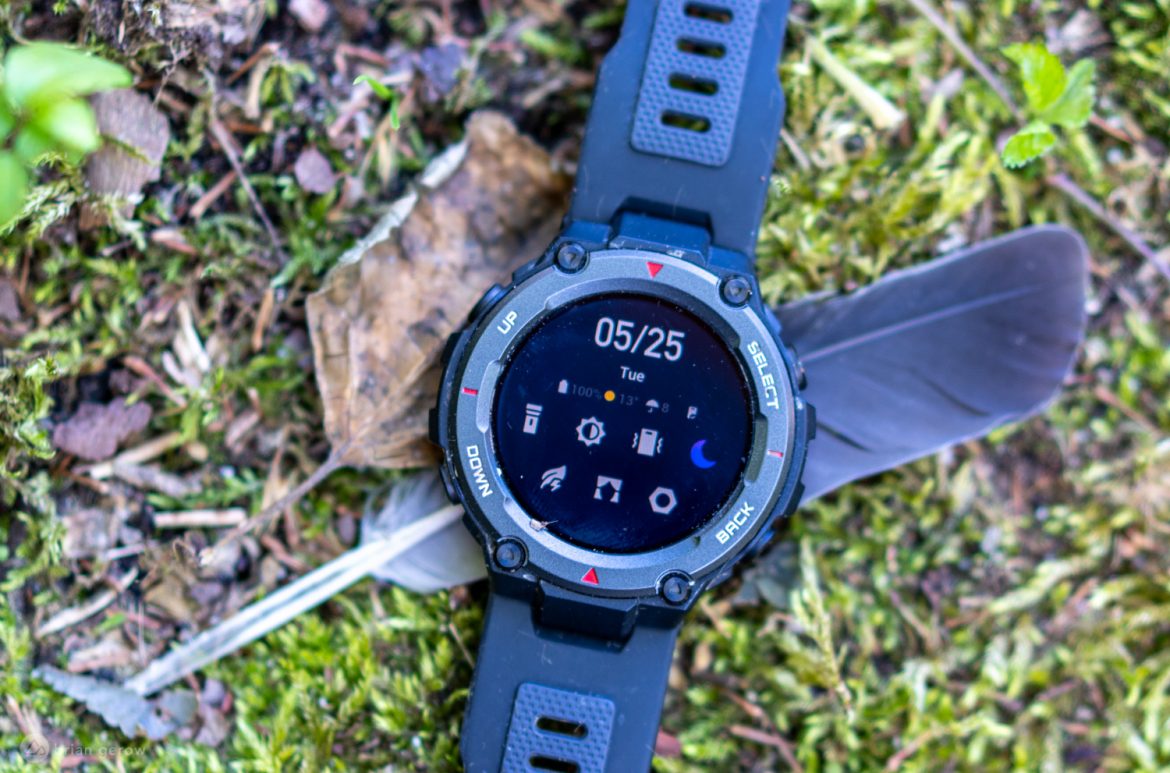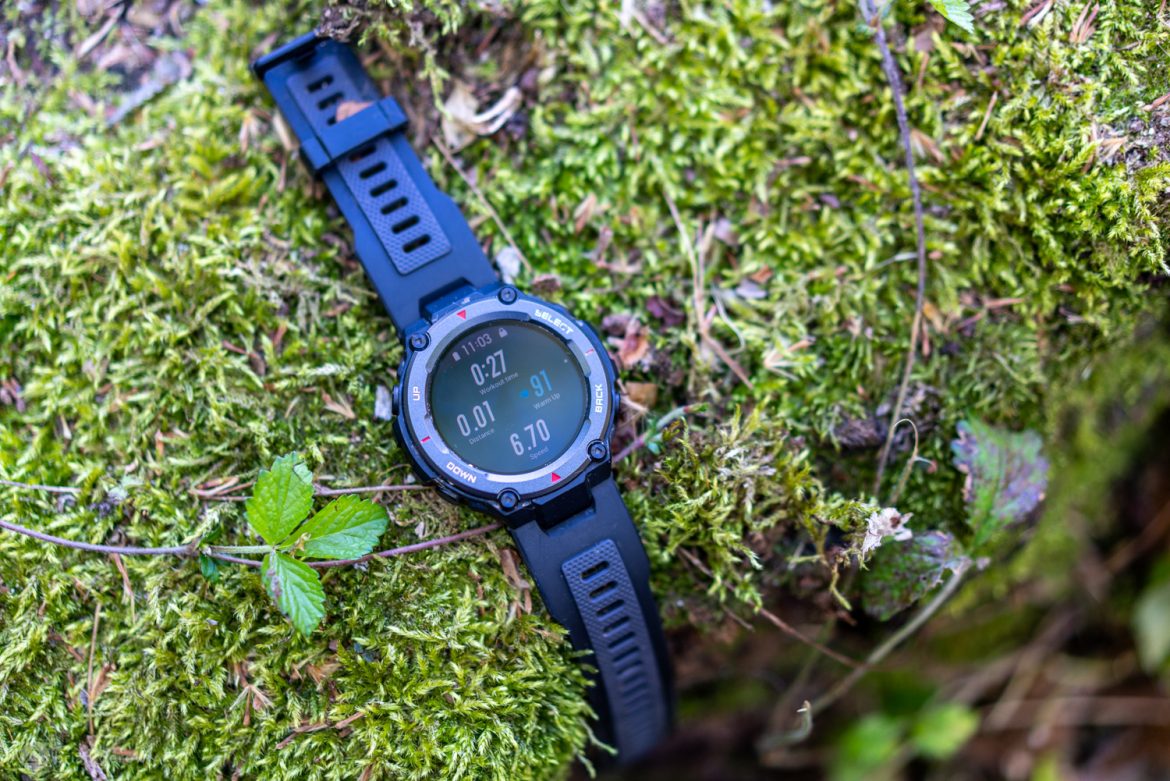
At less than half the price of most multi-sport smartwatches that offer similar features, the Amazfit T-Rex Pro looked like a sweet deal for $179.99.
It will record your bike ride, and nearly any other activity you enjoy, read heart rate and blood/oxygen levels, and report the day’s weather predictions to help you get dressed before a ride. It’s waterproof up to 100m for those post-ride lake sessions, and for fans of big tough watches, it looks and feels strikingly similar to a Casio G Shock.
Amazfit T-Rex Pro build

While the Amazfit T-Rex Pro looks hefty, it weighs a mere 59g. That’s is precisely the same weight as the Coros Apex Pro watch we tested a while back, and 5g lighter than the Polar Grit X that we reviewed last year.
That low weight coupled with the rounded plastic back and silicone strap give it a markedly comfortable feel for daylong wear. I didn’t experience any skin irritation on rough trails, and the band has just enough stretch to allow you to cinch it down so it doesn’t move without feeling overly tight.


The burly watch body is said to have passed 15 different military tests for things like impact, heat and cold variation, salt and sand, ice and freezing rain, and whatever else you could get your wrist into. Based on my bashing around and smacking it against things the chassis seems plenty tough for riding and crashing. If you prefer a smaller watch body, the Amazfit Stratos 3 passed many of those same tests, includes a host of similar features, all packed in a smaller and less tactical-looking frame.
Amazfit T-Rex Pro set up and features

Setting up the Amazfit T-Rex Pro is similar to most other multi-sport smartwatches. You simply enter your personal information in the required Zepp mobile app, and then go hit the trail.
You can connect the watch to your phone to receive notifications for texts, email, and other notifications, but there is no way to respond to those messages through the watch. Similarly, you can see and switch through the music that’s playing on your phone, but the music won’t be saved on the watch. In this case, the watch is essentially a remote control for the phone.

There is no external-app integration, so users will have to be happy with the features this watch includes out of the box. If you get excited about loading Strava rides and being alerted when you beat a former record, this watch won’t be the one for you.
It does include a compass, barometer, timer/stopwatch, alarm, activity goals and summaries, and something called Personal Activity Intelligence (PAI) that evaluates overall fitness and rest to help folks train toward different athletic goals.

Training with the Amazfit T-Rex Pro
For training, the Amazfit T-Rex Pro is designed to track your route, elevation, heart rate, steps, and blood oxygen level. The watch that I received does well to track routes, steps, and elevation, keeping a fairly narrow margin to the far-more-expensive units I tested alongside it. Similar to most other watches folks can either look at ride data in the Amazfit Zepp app or via Strava, where the info uploads every time the Zepp app is cracked open.

Heart Rate Monitoring
The heart rate monitor sensor on my watch hardly works at all, and when it does function there is rarely a reading on the screen. I am not able to get a reading from the blood-oxygen sensor whatsoever.
For heart rate, I may see a readout on the watch face for a few random minutes of a ride, and often more minutes of HR recording than what’s displayed on the screen will be reported in the data, but the watch hasn’t yet recorded a whole ride over the past several months of daily testing. I tried different wrist positions and levels of tightness with the band, to no avail.
I also submitted a number of help-desk requests via the app and then updated the software with no change. Additionally, when the watch does record heart rate data it seems fairly inaccurate. For example, If I’m doing a set of intervals, the heart rate numbers end up rather flat in the mobile app’s readout, despite there being significant dips in my actual heart rate between. Hopefully, this is an issue that Amazefit developers will be able to remedy through future software updates.
I personally like to use the heart rate reading during climbs to make sure my BPM stays above 150 to keep myself honest, and I was bummed that the watch didn’t display that data.
Additional Features
I refuse to wear a watch to bed, and particularly one this girthy, but I did give it a shot to check out the sleep tracking functionality. The recorded data seemed relatively accurate, and for folks who are training hard and need to rest harder, this could be an invaluable feature.
One other cool feature included in the Amazfit T-Rex Pro is a “find watch” button in the app and a “find phone” option in the watch. When you push this button the watch or phone will vibrate to help you locate it. For folks who adhere to a Pigpen space-management system, this feature will likely be a favorite.
Finally, it has a flashlight mode that turns the screen into a bright light, which could be super helpful in the campground once the fire is doused for the night.
Battery Life
A single charge can last for up to 18 days of normal use, tracking sleep and steps, and reportedly 40 hours in full GPS recording mode. Those battery-life durations depend greatly on how you set up the watch. For example, you can have the heart rate monitor on all the time, which decreases battery life. You can also choose to have the watch face illuminated constantly or to wake whenever your wrist is turned. This “wake” feature saves a good amount of energy and it can be further customized with a specific lighting duration before fading to black once more.
Riders can also set the brightness of the screen to their liking, and have it stay on during workouts if that’s helpful. It takes a second for the screen to light up when it’s set to “awaken” with movement, so having it remain on during workouts can be helpful.
My Amazfit T-Rex Pro battery needs recharging roughly once per week given my four weekday rides that are usually 90 minutes long, and two weekend rides that typically reach the 4hr-plus mark.
Amazfit T-Rex Pro performance on the trail

On the trail, the watch display can offer all the info you need. Page one includes the battery level, total workout time, distance, heart rate, and speed. The second screen reveals all of your up and down metrics, from current altitude to the total number of meters ascended or descended. Page three is all about current heart rate and the average over a given workout, which would be super useful for intervals if the sensor worked.
You can toggle between these pages by swiping the screen or using the up and down buttons. It’s nice to have both options, with the buttons being more convenient when wearing gloves or when the screen is damp. The “back” button can mark laps out on the trail, and the “select” button will pause and restart ride recording. It may be possible to change the information fields on these three pages, though I wasn’t able to find that adjustment in the app.
While not everyone wants to follow maps on a screen this small, I really wish the T-Rex pro at least had a breadcrumb trail to trace back to the start of a ride if you become lost. At the moment, there is no way to load a GPX file, or track your current path. This is one of the key features that will crank this watch up a few notches on the MTB computer list once the developers can add it.
Zepp phone app


The connected Zepp mobile app provides all of the information you would expect for each given ride, and can share data with Strava if you choose. The screenshots above show the map for a sloppy rain ride in Cumiana, Italy, with ride time, median speed, heart rate (supposedly), estimated calorie burn, and elevation. The second screen shows how long I rode at specific speeds.


These next two shots share heart rate and altitude information, and you can see that the heart rate monitor didn’t record a significant portion of the ride — as is the case with every recording for the T-Rex. With most multi-sport watches, a chest strapped heart rate monitor would be more accurate, but it’s not possible to connect any third-party devices to the T-Rex Pro. If you want to train with power, or accurate heart rate data, this is not the watch for you. The brand does make other fitness trackers that pair with chest straps, like the Stratos 3 mentioned above.
Finally, if you want to share your ride data with a coach or friend it will be best to do so by sharing a Strava link, as there is no share option in the Zepp app. You can share screenshots directly from the app, but those might be less fun to analyze than a Strava link for the ride.
Amazfit T-Rex Pro Summed Up
This little dinosaur-themed computer has all the bones of a great multi-sport data tracker, it feels good to wear while riding, and depending on what features you’re looking for it might just cover the bases. All of its flaws may eventually be improved and solved with software updates, and the price will be hard to compete with.
- Price: $179.99
- Available at Amazon





















2 Comments
Jul 3, 2021
Jun 18, 2021
I have the Amazfit T-Rex, the original model before they released the Pro and have been using almost close to 9 months and have been impressed with the battery life and fitness tracking features. The screen brightness is impressive as well as the battery life.
Coming from a TomTom, I was disappointed that there was no way finding feature.
Apart from that, I am satisfied with the T-Rex and will skip the Pro version for now and wait to see if they release a more feature rich version 3 later.